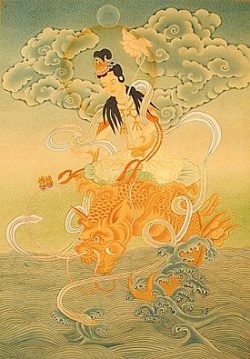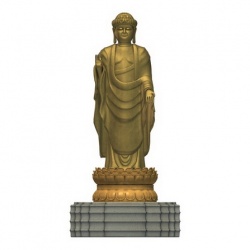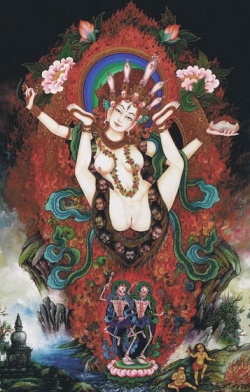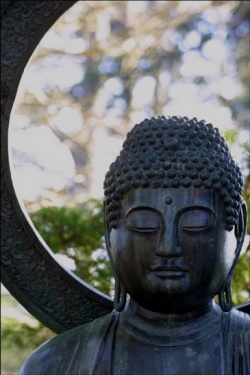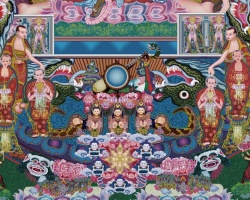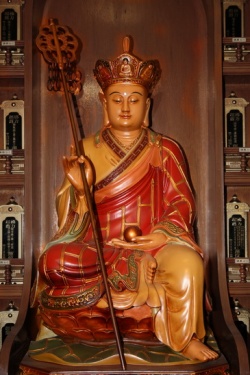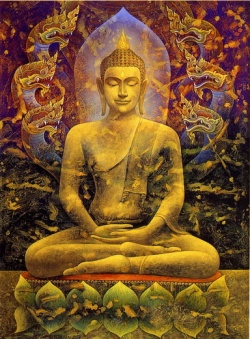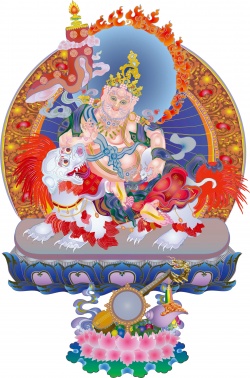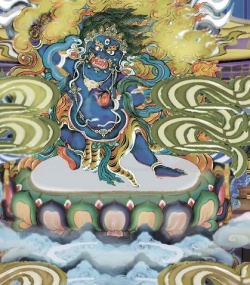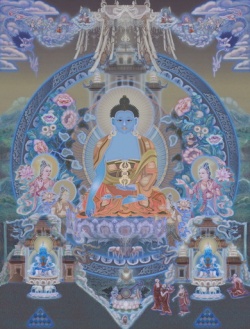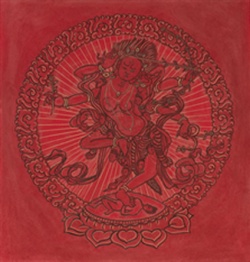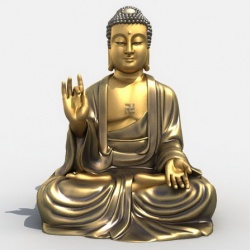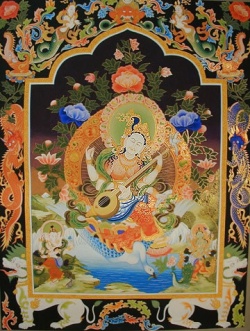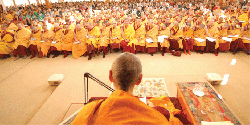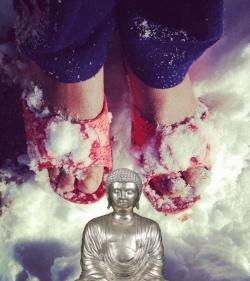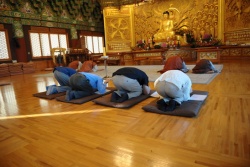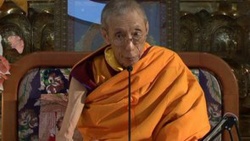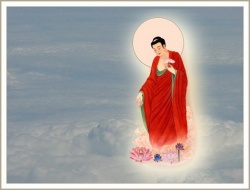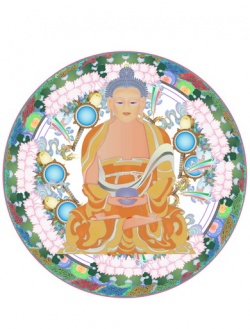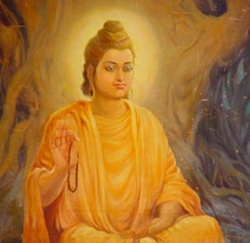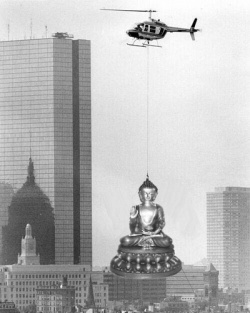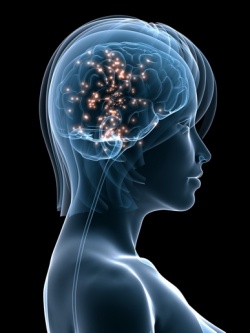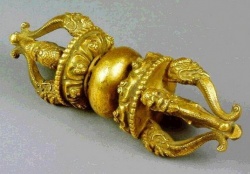The Problem of After-Life or Immortality of Consciousness-continuum
The philosophers of the Lokāyata school, who believed consciousness to be a product of physical elements and as such ceasing to function with the death of the physical body, opposed the Buddhist doctrine of the immortality of consciousness-series in very violent language. They argue: when the Buddhist believes this life of consciousness to be nothing but a congeries of distinct and discrete conscious units without any real, underlying unity in the shape of the self, then how could they believe in disembodied existence of consciousness? Consistency requires that they should subscribe to the Lokāyata doctrine of absolute extinction of consciousness after death and they should hold with the materialists that consciousness is nothing but a bye-product of the four physical elements, earth, water, fire and air held in certain juxtaposition in a physical organism.
It therefore stands to reason that consciousness should come to absolute doom, when these elements are separated by physical death, no matter whether consciousness be regarded as a bye-product or as an epiphenomenon of the same.1 And as regards the physical organism, sense-organs, and objects of perception, they also are nothing but peculiar combinations of these elements, [Page 203] as there is no reality outside these elements found by experience.2
It might be argued that the consciousness in a pre-existent body is the substantive cause of consciousness in a subsequent body and so there is no break in the continuity of consciousness even on the death of a particular body. But such a causal relation between consciousness-centres located in different bodies is absolutely unthinkable, as we find the consciousness of an elephant and of a horse to be absolutely distinct and independent. Besides, there is no instance of one subjectivity producing another in a different body, on the strength of which we could suppose this relation to obtain in a past and a future organism.
The theory that consciousness is the cause of another consciousness should thus be abandoned and it should be held that consciousness emerges as a product of the living physical organism.3 It is a bold proposition to assert that consciousness exists even in the embryonic stage. How could there be any cognition of an object in the absence of sense-organs and certainly consciousness without a content is a contradiction in terms. Likewise, there can be no consciousness in fits of swoon and the like, when sense-organs cease to function. Nor can consciousness be supposed to exist in such circumstances in the shape of a potential energy, because potentiality can exist, if at all in a substratum and as the Buddhist denies with the materialist the existence of the Self, acting as a substratum of consciousness, the organism should be regarded as the substrate and with its death, consciousness.should be held to become defunct, as there is no other [Page 204] organism in which consciousness could function.
The hypothesis of an intermediate astral body, working as the medium of the departed consciousness, has been thoroughly exposed by Vindhyavāsin and so far as the Lokāyata is concerned, it is simply an idle supposition as there is no positive proof of it. Moreover, this intermediate astral body which is supposed to originate and disappear all on a sudden, cannot be supposed to act as a vehicle of the departed consciousness, because, consciousness being devoid of locomotion, cannot be transferred to this astral body even.4 And even if this be granted, it cannot be conceived how it should deposit consciousness in another organism, as this will necessitate the existence of consciousness in an embryo, a contingency too bold to be regarded with equanimity.5 So the Buddhist finds himself to be placed tightly between the two horns of a dilemma: either he should accept an eternal Self like [Page 205] the Mīmāṃsaka or in the alternative deny metempsychosis like the materialist.6
Śāntarakṣita observes that the whole problem of after-life hinges on the correct determination of the meaning of the expression ‘after-life.’ Now, if by after-life or post-mortem existence is meant something distinct from the continuity of consciousness-series, then the denial of such an existence by the materialist will not affect the Buddhist in the least. The Buddhist holds the life of consciousness to be a beginningless, never-ending continuum, in which each precedent conscious moment is followed by a subsequent conscious moment, which derives its existence from the former and goes on producing its duplicates without end. Thus, so far consciousness qua consciousness is concerned, it is an eternal, timeless process without a definite beginning or an abrupt end.
The conception of this life or after-life is but a relative idea, according as it is considered in relation to a conventional time-standard. Thus, consciousness-continuum as delimited by a period of a hundred years or its neighbourhood is conventionally regarded as the present life and its survival after this fictitious limit is considered to be after-life or post-mortem existence. In reality, however, the procession of consciousness being a time-less existence, such standards of time-limitation are not applicable to it per se, which do apply to the physical organism, which is however an accidental adjunct to the conscious life.
It may be urged that the so-called continuum, which is said to be one, eternal fact in this connexion, is nothing but a fictitious idea and the problem of post-mortem existence consequently cannot be solved in terms of this fictitious convention, however useful it might be in other contexts. Yes, the continuum (santati) per se is an unreal fiction, but this does not affect the [Page 206] reality of the conscious units, which never come to an abrupt end but continue producing replicas of themselves to all eternity. These conscious moments are absolutely real entities and when taken in their totality they are designated by such expressions as series, continuum and the like as a matter of convenience.
This series has no independent reality outside the constituent moments, just as a forest has no existence apart and distinct from the trees, still these expressions have a pragmatic value inasmuch as they give us an idea of the entire collection in one sweep. Though the series is thus a mere name, a logical fiction quite as much as the series of sky-lotuses, since it is not conceivable either as identical with or as distinct from its constituent factors, yet there is no logical difficulty for the conscious units to form an ever-recurring, never-ending procession. Moreover, the eternity of conscious existence is a matter of logical proof.
Thus, the first conscious moment in a body may be regarded either as
an uncaused event;
or as the product of an eternal conscious principle, e.g., God and the like,
or as an eternal self-existent entity;
or as a product of the material elements;
or lastly, as the effect of a different consciousness-series.
The first advent of consciousness in the foetus cannot be conceived to be an uncaused event, as it is a historical event, distinctly assignable to a point of time. This would be impossible, if the first consciousness is a causeless event, since an uncaused entity being independent of external factors, would continue always and not occasionally. Neither can it be regarded as the effect of such eternal categories as God, space, eternal mind, etc. Because, an eternal cause would produce an eternal effect always. The third alternative involves a preposterous issue, since consciousness cannot be regarded as an unitary, eternal entity, the diversity of cognition of colour, sound and the like being manifestly a matter of direct experience.
The fourth alternative of consciousness being a product of the physical elements is open to the self-same logical difficulties, as the elements are ex hypothesi eternal, obdurate, unchanging [Page 207] entities. The successive occurrence of auxiliaries cannot be trotted out as an excuse, as an eternal entity cannot have any necessity for them. And if these elements are regarded as fluxional, this would be surrendering their own position. But even the acceptance of the elements being momentary will not help the materialist. Because the existence of extra-mental physical elements is logically untenable. So if the Cārvāka does not hesitate to surrender his position of eternal elements in the interests of logic, he should end by regarding them as mere ideas, consubstantial with consciousness. The unreality of the material world is proved to demonstration by irrefutable logic.
We think we can quote with profit in this connection the views of a comparatively modern thinker about the relation of thought and matter, particularly of our psychological operations with cerebral functions. “Surely no one who is cognisant of the facts of the case, nowadays, doubts that the roots of psychology lie in the physiology of the nervous system. What we call the operations of the mind are functions of the brain, and the materials of consciousness are products of cerebral activity.......... It is hardly necessary to point out that the doctrine just laid down is what is called materialism...... But it is nevertheless true that the doctrine contains nothing inconsistent with the purest idealism.
For, as Hume remarks (as indeed Descartes had done long before):—
‘Tis not our body we perceive when we regard our limbs and members, but certain impressions which enter by the sense; so that the ascribing a real and corporeal existence to these impressions, or to their objects, is an act of the mind as difficult to explain as that (the external existence of objects) which we examine at present’ (1, p. 24).
“Therefore, if we analyse the proposition that all mental phenomena are the effects or products of material phenomena, all that it means amounts to this; that whenever those states of consciousness which we call sensation, or emotion, or thought, come into existence, complete investigation will show good [Page 208] reason for the belief that they are preceded by those other phenomena of consciousness to which we give the names of matter and motion. All material changes appear, in the long run, to be modes of motion; but our knowledge of motion is nothing but that of a change in the place and order of our sensations, just as our knowledge of matter is restricted to the feelings of which we assume it to be the cause.
“It has already been pointed out, that Hume must have admitted, and in fact does admit, the possibility that the mind is a Leibnitzian monad, or a Fichtean world-generating Ego, the universe of things being merely the picture produced by the evolution of the phenomena of consciousness. For any demonstration given to the contrary effect, the ‘Collection of perceptions’ which makes up our consciousness may be an orderly phantasmagoria generated by the Ego, unfolding its successive scenes on the background of the abyss of nothingness; as a firework, which is but cunningly arranged combustibles, grows from a spark into a coruscation, and from a coruscation into figures, and words, and cascades of devouring fire, and then vanishes into the darkness of the night.
“On the other hand, it must no less readily be allowed that......... there may be a real something which is the cause of all our impressions; that sensations, though not likenesses, are symbols of that something, and that the part of that something, which we call the nervous system, is an apparatus for supplying us with a sort of algebra of fact, based on those symbols. A brain may be the machinery by which the material universe becomes conscious of itself. But it is important to notice that, even if this conception of the universe and of the relation of consciousness to its other components should be true, we should, nevertheless, be still bound by the limits of thought, still unable to refute the arguments of pure idealism.”7
[Page 209] Kamalaśīla observes that even if the four physical elements, which are the only stock-in-trade of the Cārvāka, are granted to be momentary and fluxional, the materialist will not succeed in making out his case that consciousness is a product of these fourfold elements, combined in various proportions. There is no proof whatsoever in favour of the position that the two sets of phenomena are causally related. Well, the causal relation is comprehended by an observation of concomitance, in agreement or difference, of a special type and not by mere presence or absence.
When causal relation is to be determined by concomitance in agreement, it must be laid down as a necessary condition that the effect in question must be perceptible and known to be non-existent before; otherwise if it is imperceptible its non-existence prior to the operations of the cause will be a matter of doubt and so the causal relation cannot be ascertained. If previous non-existence is not regarded as a criterion, things already in existence, e.g., the house and its furniture and the like, could be misconstrued to be the effect of the cause in question. Again the concomitance in absence or difference can be ascertained only if other likely causes are found to be present and the absence of a particular phenomenon is found to be invariably accompanied by the absence of another phenomenon.
Mere concomitance in absence is incompetent to determine the causal relation, as there is room for doubt that the absence of the effect might be due to the absence of some other unobserved fact. Thus, we cannot establish any causal relation between the growth of date trees and the custom of marriage within prohibited degrees of consanguinity, though it is found that date trees do not grow in a land where such custom does not obtain. The fact of the matter is that the concomitance in question, whether in agreement or in difference, must be unconditional, else the causal relation cannot be established. Let us examine if such unconditional concomitance is found to obtain between the physical organism and consciousness. Concomitance in agreement is not ascertainable, as the antecedence of the physical [Page 210] organism to the advent of consciousness in the foetus cannot be perceived by one’s own self, as such perception presupposes the existence of consciousness in it. Nor can it be ascertained in other organisms, as consciousness is by its nature incompetent to perceptual observation. Bo concomitance in agreement is impossible of ascertainment. Concomitance in absence too does not stand any better chance.
For, the absence of one’s own bodily organism prior to the disappearance of consciousness can be determined if there is a consciousness, bat this is sought to be eliminated in the process. Nor again can such concomitance be ascertained in the organism of another person. Because, consciousness in a different organism being invisible by its very nature, its non-existence on the cessation of the organism cannot be positively asserted. Nor can such non-existence be ascertained by means of inference on the strength of absence of all activity in inorganic bodies. Because, there is no such restriction that the cause should function always. Moreover, it is quite supposable that the absence of the activities may be due to the absence of perverted volition and desire, which are regarded as the cause of association of consciousness with a physical organism. So it cannot be proved that organised physical elements are the cause of conscious life.8
It may however be urged that though there may not be any positive argument for consciousness being a product of physical elements, there is no evidence either against this possibility. But this is not the case, as argument in favour of the independent existence of consciousness as an immaterial principle is not lacking. In dreams and pure imagination (vikalpa) the mind is found to work independently of any external stimulus, either through the nervous system or through the sense-channels. And [Page 211] even in reflective thought, which arises in the trail of sense-perception and interprets the perceptual experience, the mind contributes its own quota, which is not derived from an external source. All these facts which will be described in full in the course of our dissertation points to the independence of the mind existing in its own right. The problem of life after physical death is purely a spiritual problem and our spiritual existence is independent of any physical trapping, which is only an accidental appendage and which is adopted by it either as a matter of choice or of necessity, determined by its own law of existence.
Now, let us proceed to examine the thesis of the Cārvāka that consciousness is a product of the physical organism in all its bearings and aspects. Is the organism as a whole the cause of consciousness, or is it as an aggregate of manifold atoms, or is it as endowed with sense-organs or independent of sense-organs the cause of consciousness? Again, if it is a cause, is it the material cause or an auxiliary cause of the same? Now, the organism as one whole cannot be the cause of consciousness, as there is no such thing as an organic whole, which, though believed to be an objective existence independent of the component parts, is held to be an intellectual fiction by the Buddhist.
Moreover, if the whole is an organic unity constituted of the four elements, it will have a fourfold constitution, which is incompatible with its unitary character. Nor can the aggregate of manifold atoms be regarded as the cause of consciousness. Is each of the atoms constitutive of consciousness or the entire collection of them? Not the former, because in that case there will be as many consciousnesses as there are atoms in the body just as there are as many sprouts as there are seeds. Nor can the entire collection be productive of one single consciousness, as in that case there will be no consciousness, if there is a diminution of any part, say, a breach of the nose or a severance of the arm, because it is a matter of common observation that there is a failure of sprout, if any of [Page 212] the constitutive factors, say, soil, water, the wind or the season, is absent.
If it is contended that all of them contribute to the production of the sprout and the absence of any one factor or factors cannot preclude the functioning of others, then, there will be a consequent variation of consciousness in a cripple and sound body; but no such variation in consciousness is noticeable in a man, who has suffered loss of some member of the body. His culture and education persist intact as before. And in this theory, we are to expect a bigger intellect in an elephant than that in a man, because the increase or decrease of the cause is concomitant with similar increase or decrease of the effect. But as such concomitant variation is found to be absent, we shall safely repudiate any causal relation between them. Nor, again, can the body as endowed with sense-organs be responsible for the emergence of consciousness. The question is, whether the sense-organs are individually or jointly the cause of consciousness; if consciousness be the cumulative product of all the sense-organs, then, consciousness will fail to emerge or will abruptly disappear if there is absence or loss of any one of the sense-organs, as we observe that the absence of even one of the accessories entails non-production of the effect.
Nor can the sense-organs be individually productive of consciousness, because consciousness is seen to continue unimpaired even if there is loss of a sense-organ. For instance, we see that even a paralytic possesses an alert consciousness, though his active organs are rendered inactive by palsy. Certainly, a thing, whose variations are not followed by similar variations in another, cannot be regarded as the cause of the same. Besides, consciousness as the product of the sense-organs will be subject to all the limitations, incidental to the sense-organs, to wit, capacity for cognising particular types of objects and for recording indeterminate, non-relational cognitions, in other words, knowledge of particulars alone and lastly functioning in relation only to present objects.
The upshot is that conceptual and relational knowledge and memory [Page 213] and imagination will be reduced to unaccountable mysteries. Nor can unorganised matter, destitute of sense-organs, be regarded as the cause of consciousness. Because, we do not see any indication of consciousness in an arm severed from the body. If the body as an organic whole be held to be the cause, it will be one endowed with sense-organs, because an organism devoid of sense-organs is a contradiction in terms. But the sense-organs have been weighed in the scale and found wanting in the capacity credited to their account.
The last two alternatives remain to be examined. Is the organism the material cause of consciousness? The question can be answered if the essential nature of a material cause is determined and understood in its proper perspective. The material cause is that which bequeaths its essential nature to the effects, which, though differing in inessential matters, are found to agree in their fundamental constitution. The unfailing characteristic of a material cause which follows as a corollary from its essential character, is this that no modification in the effect is possible without a corresponding modification of the cause. Thus, for instance, a lump of clay is the material cause of the pot. Now, the production of the pot can be obstructed if there is effected some modification in the lump of clay itself. So an effect can be injured or modified only by producing an injury or modification in the material cause.
If the material cause remains absolutely unhurt or unmodified, there can possibly be no change in the effect, as the effect is bound up with the material from which it is produced. So it must be laid down as a universal proposition that an effect is injured or affected only if it is preceded by a similar affection in the material cause, which means the inducement of diminution in the causal energy. Consequently, there is no possibility of any injury or benefit being rendered to the effect directly and independently of the material cause—in other words, such service or disservice is possible through the medium of the material cause alone. And where an affection or modification in a particular [Page 214] entity is not preceded by a corresponding affection in another entity, supposed to be its material cause, these two entities must be set down as independent facts without any causal relation subsisting between them. Thus, a cow and a buffalo are considered to be independent entities without any causal relation whatsoever obtaining between them, because any injury done to the one is not conditioned by a similar injury in the other.
Let us see whether the dictum laid down by us in the determination of causal relation is satisfied in the case of consciousness and the bodily organism, which are declared by the Cārvāka to be causally related. Now, it is observed that the mind is disturbed by feelings of pain, hatred and the like by some unwelcome speech or disagreeable behaviour of another person, though the body is not affected in the least. Had the body been the material cause of the mind, the latter could not have been disturbed without producing an injurious effect in the former. So the plea of the physical organism being the cause of the principle of consciousness must be abandoned.
It may, however, be urged to the contrary that the mind is inflamed with passions and violent impulses, when the body is nourished and developed by nutritious and invigorating food and this points to an intimate causal relation between the two. But this is only an accidental coincidence. Moreover, it does not affect our central position that an effect cannot be modified without a corresponding modification in the cause. The fact that the mind is affected without any affection in the body is sufficient to condemn the whole plea of the Cārvāka. The fact that a mental affection sometimes coincides with a bodily modification cannot be construed into an evidence of a causal relation between the two. Because, such coincidence is found even between an external object and a subjective affection; but nobody with an iota of sanity would think the mental affection to be a product of the object for that. Thus, for instance, a man with a sensitive mind is found to faint away at the sight of a tiger or blood-shed; but this is a pure coincidence.
By similar logic we could regard the body as [Page 215] a product of the mind, as the body is seen to be agitated when the mind is perturbed with passion, or grief. These are coincidences, pure and simple. The causal relation can be established if the variation of one is found to follow a corresponding variation of the other, invariably and unconditionally. But passions are not invariably concomitant with bodily affections, as it is not a rare phenomenon that an enlightened man is immune from passions though he may have a developed physique. On the contrary a lean, emaciated creature is seen to have a strongly passionate nature. Certainly a thing cannot be supposed to be the effect of something else, when it is found to occur when that something is absent. Moreover, the relation between a physical change and a mental affection is at best a mediate and conditional one. The emergence of passions, anger or love, is contingent on the association of pleasurable or painful ideas with objects of love or anger. But these ideas are purely subjective manifestations, arising from an inexhaustible and evergrowing fund of memory-impressions deposited in the course of beginningless metempsychosis. So it is seen in the case of an enlightened being, who has completely purged himself of these false ideas, that he is absolutely immune from these solicitations of animal passions, though he might have a powerful physique. A careful consideration of all these facts knocks down the materialist’s plea that the mind is a product of the physical elements, no matter whether organised or unorganised.
We have proved the absurdity of the physical organism being the material cause of the mind or consciousness Let us consider whether the organism can be an auxiliary cause of the same. But this is also evidently an absurdity; because an auxiliary cause is that which directly helps the production of an effect. Thus the soil, water and the like are regarded as auxiliary causes of the sprout, because they directly assist in its production. If this dictum is not accepted, anything can be the auxiliary cause of any other thing. But such direct relation is conspicuously lacking between physical growth and rise of [Page 216] passions, as is evidenced in the case of enlightened persons, who are found to be immune from these inspite of their youth and possession of a vigorous physique.
In the case of unenlightened persons even, these bodily changes are not directly responsible for the emergence of such passions, etc.; they only stimulate the memory-impressions and subconscious desires that are lying dormant in them and through their medium become the remote causes of the rise of passions. And even if it is assumed for the sake of argument that bodily changes do assist, immediately and unconditionally, the promotion of these passions, it does not necessarily follow that the death of the body will entail the death of consciousness. This will be made clear by an example. Fire is certainly an indispensable factor in the production of an earthen pot (the baked one), but the extinction of the fire in potter’s furnace does not necessitate the extinction of the pot. So the possibility of the survival of consciousness after the death of the physical body is not excluded, even though the latter might be regarded (by a concession) as an assisting cause of the former. But we have seen that the whole plea of the materialist that, the body is either a material or an auxiliary cause of consciousness is a hollow and unfounded assertion.
It has been further contended that the physical organism and the mind are certainly related as cause and effect, as material and product, because they are found to be invariably concomitant. It is an established proposition that things which are invariably co-existent are in the relation of material and product and this can be brought home by a concrete example, viz., light and its effulgence. But the reason, viz., invariable co-existence, is not acceptable to the Buddhist, as the Buddhist believes in the existence of the disembodied spirit in the immaterial sphere. The common principle of debate is that the probans (the middle term, hetu) must be acceptable to both the parties, particularly to the opponent for whose conviction the argument is employed. The breach of this rule constitutes the fallacy of unproven middle term. Again, the probans employed may also prove quite the [Page 217] contradictory of the intended thesis, viz., the body maybe regarded as the product of the mind.
Moreover, the reason of invariable concomitance is inconclusive (anaikāntika). Because, invariable co-existence may be due to a reason other, than material causation as is the case with fire and liquefied copper. Thus though copper passes into a liquid stage only when fire works upon it, nobody yet thinks fire to be the material cause of the liquid copper. So it can be legitimately supposed that the protoplasmic cell enters into a later development only when it is informed with consciousness; and the co-existence, being thus due to a factual necessity, cannot be made to prove the relation of material and product between the mind and the organism.9
It may be argued that though subsequent cognitions may be products of antecedent cognitions, the primal consciousness, which is the source of these derivative conscious states, may be a. product of the physical organism and so the theory of beginningless consciousness will have no legs to stand upon. But this is only a dogmatic assumption and has no logic in its support. It: may be contended that as the other hypothesis is also an assumption, for which there is no more logical necessity, the present hypothesis may be plausible.
Not so, because this hypothesis is opposed to all reason. Thus, if the primal consciousness is derived from the physical, organism and subsequent conscious states are purely derivatives of this internal consciousness, then all our cognitions will be purely subjective. But as a matter of [Page 218] fact our cognitions are derived from both a subjective and an objective source alike, as is evidenced in sense-perception. But the theory of physical source of primal consciousness leaves no room for this peculiarity, as an effect once produced from a particular cause cannot possibly derive its being from other factors. Thus, smoke being first produced from fire cannot subsequently be produced from other causes.10
Moreover, if the organism be the constitutive cause of the primal consciousness alone and not of the derivative conscious states, what necessity is there that subsequent conscious states should not function independently of the organism? Certainly one cannot have a necessity for a thing, which does not benefit it in any way.
But the Cārvāka may rejoin:
‘Well, according to your theory, the principle of consciousness is independent of the physical organism. But why does it not function in isolation from the body, which renders no service to it?’
The answer is that consciousness does function independently of the body in the immaterial sphere. The association of the physical organism is not essential either for the being or for the functioning of consciousness. It is an accidental coincidence, due to a perverted desire on the part of a particular subject for such physical embodiment. If, on the other hand, the organism is supposed to condition even the subsequent career of conscious processes, then there should emerge a multiplicity of consciousness-streams, as the constitutive cause of the subsequent cognitions is present intact in the shape of the physical organism. [Page 219]
Thus, whatever cognitions,may be produced from the organism, each of them will go on producing their replicas without a break and the result will be an infinite variety of consciousness-streams in each living organism, an issue which is directly contradicted by experience.11 It may be contended that as the organism is only an ancillary condition and not the constitutive cause of successive conscious states, which however derive their being from the primal internal consciousness, the contingency of manifold consciousness-streams does not arise; and this hypothesis moreover gives the key to the fact of consciousness functioning only in relation to a physical organism. But this is an uncalled for and irrational hypothesis. For if the organism be the substantive cause of consciousness in its inception, there is no reason why it should function at a later stage in the capacity of an ancillary condition, particularly as the organism persists unchanged as before.
If this extravagant hypothesis is accepted, the consequence will be the impossibility of affiliating particular effects to particular causes, as the effects will not have their constitution determined by the causes. Furthermore, if the organism is the constitutive cause of primary consciousness, why should it not be so in respect of subsequent cognitions as well? Assuredly the organism has not undergone any change in its constitution. And if it is constitutionally identical in its earlier and later stages, it will be either the substantive cause as before or an ancillary condition as later on. Nor can it be supposed that the organism functions as a substantive cause even in relation to subsequent cognitions, subject to its association with the previous cognitions helping as contributory factors. Because, the plea of the organism being the substantive cause of consciousness has been proved to be logically absurd. And even if it is conceded, the primal consciousness too will be the product of a [Page 220] previous cognition working as a helping factor. But in that case the foisting of a physical element upon it will have no logical necessity, as the law of homogeneity of cause and effect and the law of the parsimony of causes equally overrule the hypothesis of the physical cause. All these objections, again, will hold good even if the physical elements are held to be momentary.
And so has it been said by the venerable doctor (Dignāga?),
“If the primal consciouness is produced from the organism, why should subsequent cognitions be determined by their compeers? Why should the all-powerful organism cease to function?”12
So it must be accepted that non-sensuous consciousness is a beginningless process. But if we arc to abide by the dictates of logic not only non-sensuous (manobuddhi) subjective consciousness, but consciousness as such must be accounted to be a beginningless principle. Well, as for the primal cognition, is it a sensuous cognition or non-sensuous in character? The former alternative is unacceptable, because there is no sensuous cognition in swoon, deep sleep and the like although the sense-organs are present intact. The reason is that a sense-organ is incompetent to envisage even external reality unless it is backed by an alert attention. So even if the first advent of consciousness in the baby is supposed to be a sensuous cognition produced by the reaction of the sense-organ on the objective world, the independent existence of previous consciousness has to be postulated.
If the primal consciousness were the product of sense-activity alone, it would be found to be so for all times, and the service of consciousness functioning in the background of sense-activity, which is invariably found to be the case in all sensuous cognitions, [Page 221] would be not only useless but unaccountable. There is no such thing as the plurality of causes; and if an effect, say smoke, could emerge from a variety of causes other than fire, this would amount to denying totidem verbis the law of causation and consequential repudiation of inference. So it must be admitted on the analogy of sense-perceptions in our ordinary experience that the first sense-cognition is the resultant of consciousness aiding and informing the sense-activity; in default, the law of causation will have to be repudiated.13
If, on the other hand, the primary consciousness is supposed to be a non-sensuous, subjective experience, unpreceded by conscious life, the result would be equally disastious. Pure subjective experience (manobuddhi), unmediated by sense-functioning, is incompetent to envisage an external reality, which is the only reality of the Cārvāka school. If this dictum is not accepted, organic privation will not operate as a bar and the distinction of blind or deaf persons would be reduced to a nullity. And even if the possibility of independent subjective experience is conceded, it requires to be threshed out whether the primal cognition is an indeterminate simple experience or a determinate judgment. It cannot certainly be determinate, because the characteristic of determinate cognition is verbal association, actual or implicit.
Determinate cognition is but a judgment, which means the synthesis or relationing of two discrete ideas and we synthesise when we think in terms of language. Whether actual words or concepts are used, the fact remains that relational thought or judgment is possible only after concepts have been [Page 222] formed and not before. But concepts or general ideas are mere abstractions and are represented by words, i.e., verbal symbols, which have nothing corresponding to them in reality. And the question arises how this verbal association, which is the invariable concomitant of conceptual thought, comes to be accomplished. Is it due to a knowledge of the conventional relation (saṅketagrahaṇāt) between a word and an object, or to the fact that a word is an essential attribute of a concept like consciousness, or thirdly, to a cognition of word and object in one sweep?
The first alternative is out of the question, as this being the first cognition, there can be no previous knowledge of the relation in question. The second alternative is equally doomed to condemnation. Because, words are of two distinct kinds, the particular with its unique individuality (svalakṣaṇarūpa) and the generic. The first has no expressive power and so its cognition cannot constitute the determinate knowledge. Nor can it be regarded as an essential constituent of a cognition, as it has as distinct an external reference as any other objective fact, say, blue. Otherwise, the blue and the like will have to be regarded as constituent factors of ideas and the result will be that the whole world of experience will be a collection of ideas and not objective facts.
Although in the theory of representational perception, which regards our ideas as copies or likenesses of external objects, the blue-content is a part and parcel of ideas, still as our perceptual knowledge has an external reference, the blue-content is not regarded as an essential attribute of our cognition but of the external object, which impinges its form on the cognition somehow. The word in its generic aspect certainly possesses expressive power, but it is not a constituent factor of cognition, but of the particular word-individual which is cognised in auditory perception. Nor can conceptual thought (vikalpa) take cognisance of the individual with all its uniqueness, as it is restricted to general ideas. So conceptual thought has to be set down to a previous memory-impression, deposited by a previous perception in the course of a beginningless career of metempsychosis. The [Page 223] third alternative that words and objects are cognised by a single act of perception is absurd on the face of it; because, words do not hover over objects or form part of the objective reality, as in that case even the uninstru cted would have knowledge of the same.14
Moreover, conceptual thought is selective in character and takes note of some one aspect to the exclusion of the rest. And what is the raison d’etre of this selective tendency? It is nothing but a particular habit of thinking, as is seen in the case of a particular object giving rise to different ideas in different persons. Thus, for instance, the body of a woman is looked upon by an ascetic as a mass of dead flesh; by a dog as a covetable morsel of food; by an amorous person as an object of love. So conceptual thought, which is made possible by a long-standing habit of thinking in a peculiar strain, points to a beginningless existence of consciousness, as a definite beginning, even in some distant past, would raise all the difficulties that beset the inception of consciousness in the present life.15
We have seen that consciousness in the sense of intellection cannot be regarded as the product of the bodily organism or. physical elements for the matter of that. The reason is that all intellectual thought or judgment presupposes the existence of notions or categories of thought, which are acquired from beginningless experience by a conscious subject. The Buddhist philosopher here differs from Kant in regarding these categories of understanding as a legacy of previous experience and not inherent in the constitution of the mind. The Buddhist however has long anticipated Kant in regarding knowledge as a [Page 224] synthesis of an a priori and an a posteriori element, but whereas-the great German philosopher regards these a priori categories of understanding as supplied by the mind from its own inherent constitution, the Buddhist traces them to a previous experience, shifting however to a continually receding past life. The explanation of this fundamental divergence of thought is to be found in the Buddhist belief in a beginningless existence of consciousness.: This epistemological doctrine of. the Buddhist is very similar to the Platonic theory that all knowledge is reminiscence.
It has become apparent that material data, whether as a constitutive cause or as a conditioning factor, cannot account for intellectual, synthetic thought and for its explanation we have to postulate the existence of the mind prior to and independent of the organism. So the grand alternative that the primal consciousness as the product of the organism is a simple indeterminate cognition will equally tumble down like a house of cards. If the original consciousness is a simple indeterminate cognition, we shall never have that synthetic knowledge, which is knowledge in the real sense of the term. It is determinate knowledge, which is capable of satisfying pragmatic needs.
Nor can simple knowledge be converted into a determinate, synthetic knowledge at any later stage of experience, as all our future experience also will be simple and indeterminate from its very constitution. Determinate knowledge presupposes a relationing of the facts of experience, a synthesis of what is immediately given in experience and what is not so given. Nor can memory be of help, as memory too is conceptual in nature, though perceptual in origin. And two particulars cannot give us the general# and all our knowledge of reality is a combination of a general and a particular idea. This combination or synthesis cannot be effected by a simple, indeterminate: cognition and for this we have to posit the. relationing or synthesising activity of consciousness.
But this relationing. is not possible between particulars (svalakṣaṇa) and this can be made clear by a study of the process as to how the conventional relation of words and meanings, or [Page 225] meanings and objects, is cognised. Now, when we relate the word ‘cow’ to the object signified, we do not relate it to the individual cow, which was experienced by us for the first time when an elderly man had occasion to speak of it as a cow. But we come to learn this relation on a subsequent occasion, when the word ‘cow’ is used in another context with reference to another ‘cow.’ The previous cow is not before the eyes and so the word cannot be affixed to it Nor can it be affixed to the present cow, as in that case the previous cow will not be denoted by it So before the relation is understood, it is necessary that we have already had a notion of the cow, that is universal and not this or that cow.
So if the first consciousness is a direct experience of the individual and not conceptual, the conventional relation of the word with the object, cannot be apprehended. Nor can the second experience be of any better help, as it is equally a simple, non-conceptual experience. Thus relational thought presupposes conceptual thought and conceptual thought is not possible if our consciousness consists of pure, simple indeterminate experience. And conceptual thought (vikalpa), which is the precondition of pragmatic activity, is possible if there is an independent thinking principle, prior to the first advent of experience, endowed with a synthetic and selective activity. This selective activity, we had occasion to observe before, is possible if there is a previous habit of thinking and this habit points to the pre-existence of consciousness before the physical organism.16
[Page 226] It might be argued though consciousnes may not be regarded as the product of physical elements, it may have its source in the consciousness of the parents. But then, the parental consciousness may be either the material cause or an auxiliary condition of the consciousness of the son. It cannot be the material cause, as in that case the son’s chain of consciousness should inherit all the peculiarities of the material cause in question, to wit, the father’s learning, culture and the like. And this is seen to be the case in the father’s own chain of consciousness; then why not in the son’s consciousness also, as the latter is the product of the former in the same sense.
It may be contended that the effect. does not inherit all the peculiarities of the cause, as for instance, one light is seen.to produce.another light, but the thickness, richness and intensity of the: flame.ia not the same in both. But the analogy of the light and the flame is not quite apposite. The peculiar intensity or richness of-fiame, etc., are but unstable attributes of the light and do not always continue. And the substratum of these attributes is none the more stable, as it is seen to-become extinct on the consumption of the fuel, wick, oil and the like. But the case is different with consciousness and its attributes. Education, culture, etc., are seen to persist throughout the career-of consciousness and consciousness too never becomes defunct, as it is not dependent for its being on any other cause. Moreover, one flame is not the material cause of another flame, as they are distinct and discrete. So the analogy is entirely out of place. Again, in the case of insects that are. born of moisture,, how can you account for their consciousness as no parent can be found for, them. If however parental consciousness is looked upon' as a helping condition, we have no quarrel with you.17
[Page 227] So primal consciousness must be admitted to have its source in the previous consciousness of its own series on the strength of experience of the career of consciousness in the present life. More so as other likely alternatives, to wit, God, space, physical elements and the like have been found to be improvable, and as consciousness has a historically assignable place, it cannot be regarded as an uncaused category. So pre-existence of consciousness is established beyond doubt. And as regards survival of consciousness after physical death, it can be easily inferred from the nature and function of consciousness. We know consciousness has the power to produce another consciousness and thus the continuity is maintained in our present life and as the consciousness-moment at the time of death has the same attachment and passions and desires that characterise the whole career of consciousness in the present life, there is no reason why it should not culminate in another consciousness. Certainly things having self-same nature and function cannot behave capriciously, as caprices of nature are logically unthinkable.
The Cārvāka cannot still maintain that consciousness is a direct: product of the organism, as the causal efficiency of the organism in respect of consciousness has been exposed to be a hollow pre-tension on the pain of simultaneous emergence of all possible cognitions. It is a matter of positive demonstration how attention aroused produces memory and memory rakes up pleasurable or painful ideas associated with an object of love or hatred, say, a woman, and finally culminate in a strong passion of love or hatred. Moreover, repeated mental exercises or lack of them in, the matter of science and arts are seen to be followed by a. heightened or lower intellectual efficiency.
Furthermore, when [Page 228] the mind is engaged with a particular object, the expected cognition of another object though present to the senses does not take place. All these lead to one and only one conclusion, viz., the independent existence of consciousness, as controlling and directing the physical organism as an apparatus. And as all other alternatives fail, we have willy-nilly to accept that consciousness alone is the substantive cause of another consciousness. And the objection that consciousness located in one organism cannot operate as a cause of consciousness in another organism has no substance in it. Because, consciousness being an incorporeal substance cannot be supposed to be located in a physical organism. Certainly consciousness is not a gravitating object so that a locus may be necessary for its being or functioning.
Nor can consciousness and the organism be regarded as identical in substance by the materialist. The idealist, who denies the existence of anything but ideas, can regard the body as identical with consciousness, but this sounds like a paradox in the month of a rank materialist. And how can these two distinct phenomena be identical in character, when they are found to differ in every respect. The body is liable to visual perception. But consciousness is exactly the reverse of it.
And how can the two be identical, when they are possessed of contradictory attributes? And if they are identical, the body would be as much fluxional as consciousness, which disappears in the next moment of its birth. The objection that consciousness in one body cannot be the cause of consciousness in another body is based on an obvious misreading of the nature of bodily organisms. The organism is equally momentary and so there is no one organism as the basis of operations of consciousness. There is no difficulty for consciousness to function though the organism differs every moment; and if difference of organism does not operate as a bar, why should there bo any difficulty if another new organism is adjoined to it in the next birth?
The objection of Kumārila that consciousness cannot exist in an embryonic form, as there is no sense-organ in it, is based [Page 229] on partial observation. Certainly it is sheer foolhardiness to insist that all cognitions are sensuous. What about dream cognitions, which arise independently of sense-organs? And these cognitions are not objective cognitions (arthagati) either, which Kumārila holds all cognitions to be. There is no difficulty, therefore, for consciousness persisting even in fainting fits, though sense-organs cease to function that time. We do not believe that consciousness exists in the form of a potential energy in these states; we hold that it exists in its own nature and so the objections based on it do not arise at all. And there is no proof of its non-existence either.
How do you know that there is no consciousness in these states? Is it from absence of self-perception? But this awareness of absence of self perception proves the existence of consciousness in these states. It may be contended that had there been any cognition in these states, a person would remember on awakening that he had such cognitions. But as no memory follows, it is proved that there was no consciousness. But this is the result of a hasty generalisation that all cognitions should be followed by memory, which is not the case. Only those cognitions are followed by memory, which possess intensity and which arc repeated and have a special interest, and cognitions which lack these conditions pass into oblivion like the cognitions of a new-born baby.18
It may be legitimated asked if there is any positive evidence of consciousness existing in these states. The answer is that subjective consciousness is independent of external conditions, such as sense-organs and is produced by its own cause, viz., the preceding consciousness. If there be no consciousness in these [Page 230] states, it would mean death, as death is nothing but cessation of consciousness iu physical organism. If it is held that consciousness emerges into being after a lapse, then, there would be no such thing as death, as there is no reason why consciousness should not re-appear in a dead body though it might have lapsed for a time. What demarcates these abnormal conditions from death is the presence of consciousness in the former and its total absence in the latter. If there is total absence of consciousness in these states also, there would be no reason to consider them distinct from death.19
But since subjective consciousness as distinguished, from objective cognitions (arthagati) is independent and absolutely unconditioned by external stimuli, the existence, of consciousness in the embryonic stage is not barred out. Moreover, it has. been proved that conceptual and imaginative thought are absolutely independent of sense-functions and objective reality. If all our thoughts had been determined by sense-experience, we could have had no such ideas as of sky-lotus and the like, which are subjective fictions, pure and simple. And even the reflective thought that arises in the trail of sensuous intuition is purely an activity of subjective consciousness.
So subjective consciousness being absolutely independent of physical environment, the death of the physical organism cannot arrest its continuity. The independent existence of consciousness prior to the organism being thus established by irrefragable logic, we do not insist on the reality of the intermediate, astral body. But there is nothing absurd in this supposition, as non-perception constitutes no evidence against its existence, the astral body being ex hypothesi composed of subtler stuff.
[Page 231] The contention that there can be no continuity of consciousness in different organisms is absolutely, unsubstantial, as the association of organisms is accidental, so far as the inherent nature; of consciousness is concerned. That the consciousness m.cow is different from that in the horse is not due to the difference of organisms, but to the intrinsic difference of nature, by which one centre of consciousness is demarcated from another. The continuity of previous consciousness in a newly-born organism is proved by the fact that the child evinces peculiar intellectual and moral characteristics which presuppose a long course of training in previous lives. The pre-existence of consciousness is further proved by the fact that the new-born baby at once seeks for the mother’s breast to satisfy its hunger.
This shows that the child is born with memory impressions, acquired in previous lives, otherwise bow could it know that the. mother’s, breast contained nourishing food for it? Again, the child begins to cry when its mouth is forcibly removed from the mother’s breast and is satisfied when the breast is applied to the mouth. Certainly it could not acquire these experiences in its present life. Even among animals it is found- that the monkey-child clings to the mother’s person for fear of death from a fall. How could these phenomena be accounted for unless previous knowledge is postulated? These activities unmistakably testify that the new-born baby has powers of synthetic judgment and this is possible if the mind can independently bring to bear upon sense experience some basic ideas, the categories of understanding. And how could these ideas be there, unless it is assumed that they were acquired in a past life? No determinate thought is impossible unless the mind does supply from its own fund these fundamental categories. Sense-experience alone is never capable of giving us that determinate knowledge, which is made possible by synthesis, which again presupposes possession of basic ideas. This synthetic judgment is possible if the mind can think in terms of words and the knowledge of these words could only be acquired in previous lives.
[Page 232] But it may be contended that if this synthetic thought-activity is the result of memory-impressions of verbal associations of conceptual thought acquired in previous lives, then, why does not the new-born baby remember the actual words or express his thoughts in distinct, articulate language like an eloquent speaker? But as there is no such memory of verbal expressions and as the baby docs not give articulate expression to his thoughts, this hypothesis is absolutely an insensate supposition. But this objection is futile, as it is not an unusual phenomenon that there may be previous experience and subsequent loss of memory. In fact memory is a delicate faculty and suffers lapse, if there is a violent shock in the organism.
Thus an attack of typhoid is seen to obliterate memory of previous experience. Here too the memory-impressions have passed through a violent shock during the period of confinement in the mother’s womb and so have not had the opportunity to reach the stage of maturation, which makes remembrance possible. So the objection of the materialist on the score of loss of memory does not carry weight. The example trotted out by him that all the people coming from the same village remember the past incidents (in the village) contains only a half-truth, as persons having a bad memory fail to recall these incidents. That this is the case is borne out by the fact that persons of extraordinary spiritual powers do exactly remember their past history and distinctly articulate their thoughts as soon as they are born. The reason is that the confinement in the mother’s womb could not impair their mental faculties, which have reached the highest degree of development.
Moreover, some people in their very boyhood are seen to evince strong passions of love, hatred, jealousy, pride and others again display a superior intellectual power, a kindly disposition, dispassionate love and friendship and the like. What might be the cause of this intensity of passions and intellectual and emotional refinement? Certainly it is neither the environment, nor even the objects, that can be supposed to have a bearing on these [Page 233] emotional idiosyncracies, as enlightened souls are not affected with these passions though the objects may be present in their fulness. They are again seen to emerge with a vengeance when people are not in a mood to philosophise on their worthlessness.
These passions are seen to arise even when the objects are lost or dead or not even born. Moreover, these objects cannot be supposed to possess all the fine and good attributes that are associated with them. These good or bad qualities are only creations of subjective fancy, but are superposed on them by the persons concerned owing to their own inherent tendencies. If the objects were really good, and beautiful as they arc supposed to be, they would appeal to the imagination of all with equal force. So these emotions and passions must be regarded to be purely subjective facts, growing in intensity and volume according to the strength of habits of thinking. But as the intensity of these emotional and intellectual faculties cannot be explained by the habits of present life alone, they must be supposed to have been occasioned by habits of previous lives.
It may be urged that if the presence of objects is not the cause of these passions, then how is it that these passions are seen to emerge when the objects are presented to the senses? The reason is that these objects produce pleasurable or painful sensations and these stimulate the latent memory-impressions, which, when roused, culminate in the stimulation of passions of love or hatred in the minds of those, who are given to indulge in such unfounded speculations. This is seen to be the case with persons who are in the grip of ignorance and who ore averse to enlightened thinking. But these objects utterly fail to evoke any response from, those, whose minds have been purified by a course of ethical.and philosophical discipline. If these passions were the effects of these objective facts, they would have produced these results in the minds of the enlightened and the unenlightened alike
But the Cārvāka may rejoin:
‘Well, these passions cannot be construed into evidence of previous births, as it is quite likely [Page 234] that these are originated either by direct experience of the behaviour of others or by communication with those having firsthand experience.’
But this is no explanation; even animals, which cannot be supposed to profit by such example or communication, are seen to develop these passions in the presence of the opposite sex of their group. Nor can it be supposed that these passions come out spontaneously; had it been the case, such virtues as enlightenment, mercy, moral elevation and the like, which are known to arrest the career of metempsychosis, would also have come out spontaneously. But it is a matter of common experience that these require to be cultivated by a prolonged course of discipline and training before they become part of our nature.
There are some thinkers who maintain that the passion of love is generated by the prevalence of phlegm, hatred by bile and infatuation is the effect of wind. But; this is absolutely an unfounded supposition. It is not unfrequently seen that a phlegmatic person has a violent anger and a bilious man has a loving nature. Moreover, the increase or decrease of phlegmatic humour is not found to be accompanied by a corresponding increase or decrease of love. Certainly, the relation of cause and effect cannot be supposed to exist when the variations of One are not concomitant with the Variations of another. So this theory must be abandoned.
On the contrary, it must be granted that the strength or weakness, intensity or incapacity of -these passions and impulses, which exercise so much influence on the moral, intellectual and spiritual progress of the individual, is derived from the previous habits of life and thought acquired in past lives. The present life and environment; cannot be conceivably held responsible for all these good and evil tendencies, for which sufficient latitude in time should be allowed. There is no doubt that a good deal of the ills of the present life is due to environmental conditions, to a hostile or indifferent milieu, which are remediable by a better adjustment of the state and society, in other words,—by the present karman of man in his [Page 235] individual and collective capacity.
But there will ever remain an undeniable residuum, a soupçon of individuality, in the life of the individual, which cannot be explained in terms of the present circumstances, to which a man is born. The law of karman, it may not be out of place here to observe, emphasises this freedom of will and choice, which lies at the basis of all social and political reform. An individual can do or undo, make or mar his fortune and when the doctrine emphasises the inexorable and relentless character of past karman, it only does so with a view to encouraging the individual to put forth greater exertion to undo the evil, that is his present heritage. The evils of heredity too are not insurmountable barriers. They are the creations of his own and so can be altered or undone by his own efforts. The materialist fails to give this encouragement to man, as he makes him a plaything of chance, for which there is no room in the philosophy of karman, which the Buddhist along with all other Indian systems of thought propounds as the solution of the evil that is found to hold sway in this imperfect world.
It is established, therefore, that the materialist’s theory of origination of consciousness from matter, whether organised or unorganised, is absolutely unsatisfactory, as it fails to account for the variety and wealth of the manifestations of consciousness in various spheres of existence. Not to speak of its failure to give ethical and aesthetic satisfaction it is metaphysically untenable as it leaves a large part of our conscious life and experience unexplained and unaccounted for. It seeks to immolate the rationalistic tendencies of our thought-life at the altar of a false God, the all-powerful matter, for a mess of pottage.
The better minds of every age and clime have persistently refused to be seduced by the meretricious charms of this harlot of false philosophy and have tried to give us a philosophy, that satisfies to a far greater extent the aesthetic, moral and intellectual demands of humanity—the demands which lie too deep-seated in our nature to be lightly brushed aside. We have not hesitated [Page 236] to give in the present chapter a full exposition of the honest attempts of two Buddhist philosophers who flourished over twelve centuries before, though some of their arguments seem to have been deprived of their logical value by the advanced researches of modern physiology. But the Buddhist philosophers have no doubt succeeded in making out a very strong case against the materialist and this redounds to their glory, all the more as they could not reinforce their metaphysical arguments from the contributions of modern scientific researches.
References.
Tattvasaṅgraha, Śls. 1857-1964.
Du. Pañjikā, pp. 519-550.
Footnotes:
1.
‘paralokino’bhāvāt paralokābhāva’ iti, a sūtra of the Lokāyata system quoted in T. S. P., p. 520.
‘pṛthivy āpas tejo vāyur iti catvāri tattvāni tebhyas caitanyam’ iti. (another sūtra). tatra kecid vṛttikārā vyācakṣate utpadyate tebhyaś caitanyam, anye’bhivyajyata ity āhuḥ.’
Loc. cit.
2.
sanniveśaviśeṣe ca kṣityādīnāṃ niveśyate—
dehendriyadisaṅjñe’yaṃ tattvaṃ nā’nyad dhi vidyate ||
T. S., 1860.
cf. tathā ca teṣāṃ sūtram—“tatsamudaye viṣayendriyasaṃjñā’ iti.
T. S. P., p. 520.
3.
kāyād eva tato jñānaṃ prāṇāpānadyadhiṣṭhitāt |
yuktaṃ jāyata itye ’tat Kambalāśvataro ’ditam ||
śl. 1864.
cf. tathā ca sūtram—‘kāyād eva’ iti. T. S. P., p. 521.
4.
‘astīha sattva upapādukaḥ’—Buddha.
5.
The entire argument put in the mouth of the materialist is bodily taken mutatis mutandis from Kumārila’s Śloka-vārtika. The Ślokas from 1865 to 1868 are reproduced verbatim and Śls. 1869 to 1871 are but a summarised version of Kumārila’s Ślokas, 59-64 and 69 to 73, Ātmavāda, S. V., pp. 708-07.
Śrīdhara in his Nyāyakandalī employs similar arguments to prove the impossibility of metempsychosis in the Buddhist theory of Soul or rather no-Soul. Śrīdhara opines that the theory of momentary consciousness would land the Buddhist in rank materialism, which denies post-mortem existence of the Soul or conscious life, to be accurate. We are tempted to believe that Śrīdhara has borrowed his arguments from Kumārila whom he quotes with great respect in other places. It is strange that the editor of the Tattvasaṅgraha has failed to enumerate the Ślokas 1865 bo 1868 in that work in the list of quotations from Kumārila, given as an appendix. Perhaps the omission to mention Kutnārila as the author of the same by Kamalaśila is responsible for this overt omission on the part of the editor. It is absolutely necessary that these ś lokas should be noticed in the appendix of the Tattvasaṅgraha.
Vide Nyāyakandalī, p. 81.
6.
ekajñānāśryas tasmād anādinidhano naraḥ |
saṃsārī kaścid eṣṭavyo yadvā nāstikatā parā ||
T. S., Śl. 1871.
7.
Huxly’s Hume, Ch. III, pp. 80-82,
8.
parispandādikāryādarśanād apy abhāvaniścayo na yuktaḥ, nā’vaśyaṃ hi kāraṇānāṃ kāryabhāvattvam, api ca dehaviśeṣaparigrahahetos tṛṣṇāviparyāsalakṣaṇasya svakāraṇasyā’bhāvāt kiṃ tatra buddher abhāvaḥ, āho svid dehavyatirekād iti saṃśayaḥ.
T.S.P., p. 526.
9.
syād etad—yayoḥ saḥasthitiniyamas tāv upudānopādeyabhūtau, yathā pradīpaprabhe. asti ca sahasthitiniyamaḥ śarīramanovijñānayor iti svābhāvahetuḥ. tad ayam anyatarāsiddhō hetuḥ, virūpe dhātau śarīram antareṅā ’pi manomater abhyupagamāt. nā’pīṣṭāsiddhir manomater api dehaṃ praty upādānatya prasaṅgāt; anaikāntikatā ca hetubhedād api sāhāvasthānasambbavāt, yathā ’gnitāmradravayoḥ. tathā hi—vahnisahakāri tāmraṃ dravatvam ārabhate, na kevalam, evam ihā ’pi dehasyo’ pādānam kalalādi. manovijñānasahakāri deham uttaram ārabhate, ity atas tayoḥ sahasthānam nō’ pādānopādeyabbāvād ity ato ’nekānta eva.
T. S. P., p, 529.
10.
athā ’pi syāt—yady apy uttara-kālaṃ mano-dhīḥ pūrvapūrvabuddhiprabhavā bbavati, tathā ’pi yā prathama-kālabbāvinī tasyā dehopādānatvād ato nā ’nādivasiddhir iti. tad etad asamyak, na hy asyāḥ kalpanāyāḥ kiñcit sādhakaṃ pramāṇam astī ’ti pratipāditam etat. bādhakam api nāstī ’ti cen, na, vidyata eva bādhakam. yadi dehāt sakṛd utpannā satī manodhīḥ paścāt svajātisamudbhavā syāt, tado ’ttarakālaṃ sarvadai ’va pūrvapūrvamanovijñānasamudbbavai ’va syāt, na vijātīya-cakṣurādivijñāna-samudbhavā. na hi dhūmo ’gneḥ sakṛd udbhūya paścād anyato vijātīyād bhavati.
T. S. P., p. 529.
11.
atho’ttarakālaṃ dehasyā’py upakāritvam aṅgīkriyate, tadā’nekavijñānaprabandhaprasavaprasaṅgaḥ.... na cai’vam anubhavo’sti.
Ibid, p. 530,.
12.
ata evā’nityabhūtapakṣe’py etad ācāryīyaṃ dūṣaṇaṃ sutarāṃ śliṣyati. yud āha—
“dehāt sakṛd yad utpannā dhīḥ svajātyā niyamyate |
parataś cet, samarthasya dehasya viratiḥ kutaḥ ||”
(The verse has been emended by me from what appeared to be a faulty quotation, both in metre and matter).
Ibid, p. 530.
13.
tathā hy ādibuddhir bhavantī akṣabuddhir vā bhavet, manobuddhir vā? na tāvad ādyaḥ pakṣaḥ suptamūrcchānya-(dya?)-cittānāṃ saty api akṣo’nuguṇamanaskārābhāvād akṣabuddher anutpatteḥ. ato na kevalam indriyam akṣabuddheḥ kāraṇam, api tu mana-kāraviśeṣasāpekṣam iti niścīyate, anvaya-vyatirekasamadhigamyatvāt kāryakāruṇabbāvasya. na cā’pi yato yat prathamataram utpadyamānaṃ niścitaṃ tat tato’nyasmāt parastāt udayam āsādayati ahetukatvaprasaṅgāt.
T. S. P., pp. 530-31.
14.
Vide T. S. P., pp. 531 (I., 6)—582 (L. I).
15.
kiñ cā’nityādirūpeṇā’rthasyā’viśeṣe’pi na vikalpaḥ sarvān ākārān yugapad vikalpayati, ākārāntaravyavacchedena pratiniyataikākāropagraheṇai’va vikalpasyotpatteḥ. ataś cai’kākāravikalpane kāraṇaṃ vaktavyam. na cā’bhvāsāt tad anyad vaktuṃ śakyam, yathā kuṇapādivikalpānām. tataś ca pūrvābhyāsavaśena vikalpakasya pravṛtter anādir vikalpabuddhir iti siddham.
16.
athā’vikalpike’ti pakṣas tadā na kadācid vikalpikā buddhir utpadyate. proktanītyā saṅketavaśād uttarakālam utpadyata iti cen, na; nirvikalpakajñāne sthitasya puṃsaḥ saṅketasya kartum aśakyatvāt. tathā hi na yāvac chabdasāmānyam arthasāmānyaṃ vā buddbāv uvabhāsate na tāvat saṅketaḥ śakyate kartum. na cā’vikaipe vijñāne sāmānyaṃ pratyavabhāṣate, yac ca pratyavabhāṣate svalakṣaṇam, na tatra tena vā saṅkataḥ(?) kriyate, vyavahārā thatvāt tasya. na ca saṅketa kāladṛṣṭasya svalokṣaṇasya vyavahārakāle’sti sambhava iti na svalakṣaṇe, saṅketakaraṇāt pūrvaṃ vikalpo’vaśyābbyupagantavyaḥ. sa cā’bhyāsam antareṇa na siddhyatī’ti siddhā’nāditā.
T. S. P., p. 532.
17.
atha matam—yathai’kasmāt pradīpād dīpāntarotpattau na pūrvadīpasaṃskāreṇa sthaulyādilakṣaṇena viśiṣṭasyo’ttarasya dīpasya sambhavaḥ, kiṃ tarhi? nissaṃ kārasya pradīpamātrāsyo’tpattiḥ...... tadvat tadbuddher iti, tan na, yasmāt pradīpādisaṃskāraḥ svāśraye’pi tāvat santānaṃ, nā’vabadhnāti asthiratvāt tasya, tathā hī’ndhanāpacaye tasyai’va dipasyā’sattvaṃ dṛśyate, na tv evaṃ śrutádisaṃskāraḥ, ato na dīpādivan niss aṃṣkārasya buddhimātrasya sambhavo yuktaḥ...... api ca saṃ-vedajā tīnāṃ mātai’va nāsti, teṣāṃ katham anyavijñānajā buddhir ity alaṃ prasaṅgena, atha sahakārikāraṇam iti pakṣas tadā siddhasādbyatā.
T.S.P., p. 534.
18.
Vide T. S., Śls. 1923-1927.
cf. yadi hy anubhūta ity etāvānmātreṇai’va smaranaṃ syāt, syād etat, yāvatā saty apy anubhave pāṭavābhyāsārthitvādiva (?) kalyāt smaraṇam na bhavati, yathā sadyojātādyavasthayām anubhūtasyāpi cittasya.
T. S. P., p. 541.
19.
syapnamūrchādyavasthāṣu ci’taṃ ca yadi ne’ṣyate |
mṛtiḥ syāt tatra ca’tpattau maranābhāva eva vā |
svatantrā mānasī buddhiś cakṣuradyanapekṣanāt |
svopādānabalenai’va svapnādāv iva vartate |
T. S., Śls. 1929-30.

